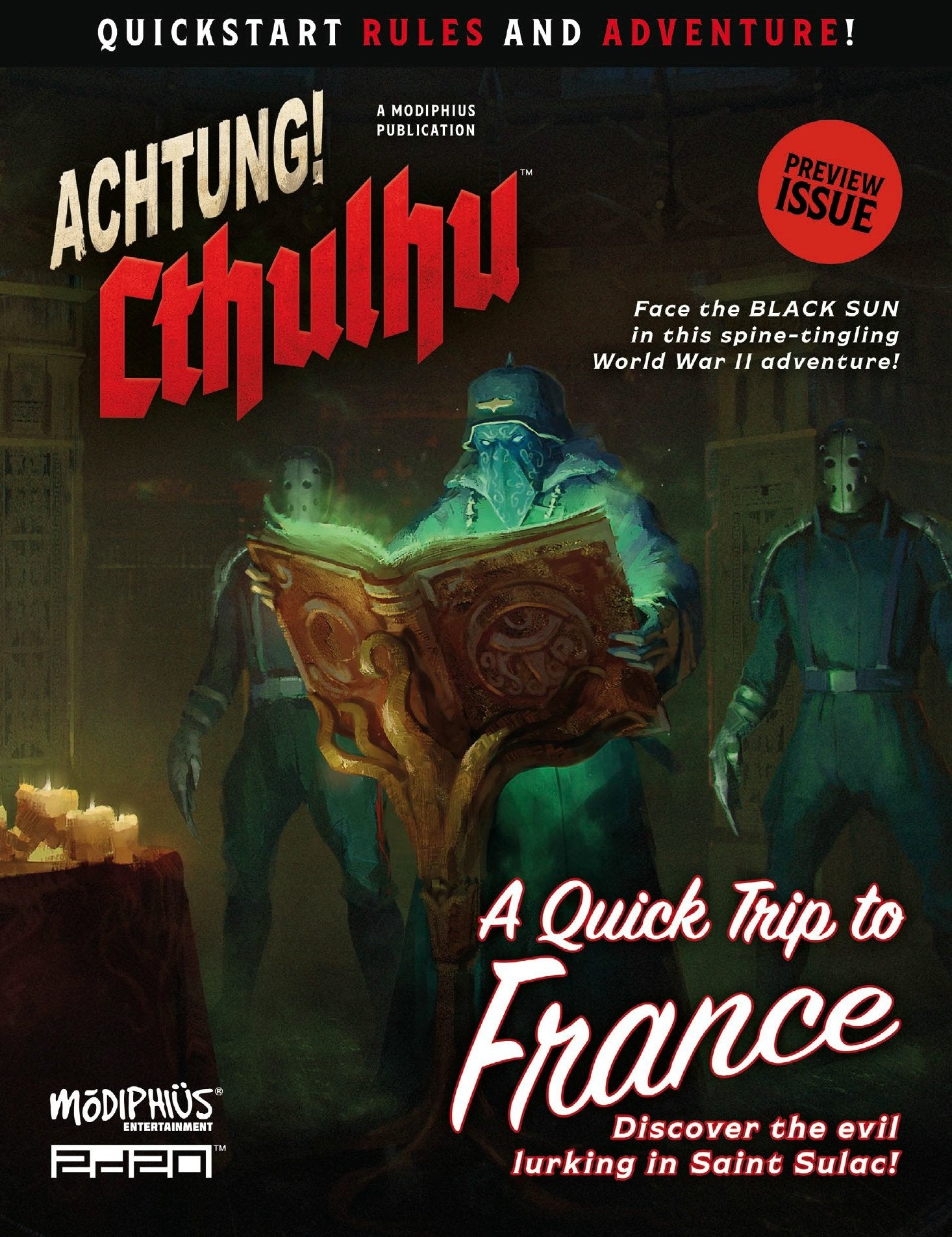Modiphius comes full circle with the release of Achtung! Cthulhu 2d20. The company established itself with the Achtung! Cthulhu Kickstarter in 2013. The game was originally released with Call of Cthulhu and Savage Worlds rules and a Fate version came a few years after. Now that 2d20 has become a calling card for the company, it makes sense that an adaptation into the house system would follow. I got a review copy of Achtung! Cthulhu Player’s Guide and Achtung Cthulhu! Gamemaster’s Guide from Modiphius and I was shocked to discover that this was my favorite version of the game yet.
Achtung! Cthulhu mixes Lovecraftian lore with World War II adventure tales. It’s a game where you punch Nazis with one fist and Cthulhu cultists in the other. Rather than the sanity blasting countdown clock of other Mythos games, this is more akin to action horror in the style of Evil Dead or Blade. The premise is fairly simple. Not only are the players trying to stop the spread of Nazi evil across the world in the 1940s, but they are also racing to keep the bad guys from exploiting eldritch powers to achieve those goals and beyond. What if the Ark of the Covenant was actually a way to communicate with the Great Old Ones?
This edition takes a further step towards the action direction by shifting the stories into something more akin to the recent Wolfenstein games or the first Captain America film (and its corresponding What If? episode starring Captain Carter). The game uncovers a secret war beneath the historical conflict featuring six factions. The British have Section M, run by an eccentric English noble with the money and the pull to get the government to entertain his notions of occult truth. The Americans have Majestic, who tend to discover ancient Mythos spells and artifacts, figure out just enough how to use them and then point the glowing end at the bad guys before they go off. The Axis powers are split between Black Sun, a Hydra style occult secret society that wants to use the war machine for a more insidious goal and Nachtwolfe, mad scientists enamored with using alien technology to win the war. The Mythos elements most directly involved in the war are the Mi-Go and the Deep Ones, though there are plenty of examples of the Great Old Ones getting their tentacles dirty in affecting the outcome of battles.
Characters are built by plugging together three blocks; what your character did before the war, what they are doing during the war and a defining characteristic. This process works well enough to get players ready to fight with a single character trait to hang on like old war movies, but I admit, with the rich history of both the Cthulhu Mythos and World War II, I would have loved to see something more akin to the lifepath setup from Star Trek Adventures.
While recent entries like Dune have leaned into more narrative directions, this version of 2d20 is more akin to earlier versions like Mutant Chronicles.There are some nods to more recent designs like choosing to fail and using Truths as modifiers, but the game digs into heavier combat and magical resolution. Weapons have both stress effects and other qualities that can affect them. The book details weapons in fine historical detail and offers some vehicular combat rules as well.Picking up equipment is handled via an abstract point system, supported by some mechanical support for finding weapons and equipment in the field.
Magic gets split into three categories; traditional, researcher (aka Mythos spells) and dabbler. Traditionalists hail from an expected magical background, such as druids or Viking rune masters. Researchers are more of the spellbook types that learned their magic more recently. Anyone can be or become a dabbler at the risk of learning a flawed spell that can fly out of their control on a bad roll. What I really enjoyed was the short section on how to make your own spells. That allows spells from earlier editions to be converted easily or even pulling favorites from other games.
The pulpier shift in direction paid off for me. The original versions started off with lengthy historical discussions of World War II that sapped some of the pulp energy out of the game for me. This one jumps into talking about the game assuming the reader is familiar with both the Mythos and history. I’ve been looking for a game like this since Captain America: The First Avenger and leaning into the dieselpunk trappings really engaged me in a way previous editions did not. I’m also fresh off a Fallout campaign for Theatre of the Mind Players, so I have a better understanding of how to run 2d20 tactically.
Achtung Cthulhu 2d20 is a great choice for fans who want the three P’s at their table: pulp action, punching Nazis and preventing Cthulhu.
This review contains affiliate links. If you found it useful, please consider supporting me by purchasing the games via these links.





